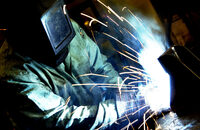 It could be argued that the first Ghostbusters movie, released in 1984, is one of the greatest films of all time; it stars Bill Murray and has a brilliant theme tune. The movie also transcends the cinema screen and provides insight into environmental law and policy with regard to Personal Protective Equipment (PPE) in the workplace. Here, Clive Jones, Managing Director of Global Heat Transfer explains the importance of PPE.
It could be argued that the first Ghostbusters movie, released in 1984, is one of the greatest films of all time; it stars Bill Murray and has a brilliant theme tune. The movie also transcends the cinema screen and provides insight into environmental law and policy with regard to Personal Protective Equipment (PPE) in the workplace. Here, Clive Jones, Managing Director of Global Heat Transfer explains the importance of PPE.
Standard Ghostbusters kit included ecto goggles for eye protection and coveralls to protect the body against rogue ghost-slime. However, despite the fact the three main characters were scientists, the protection was not thoroughly considered. During the film, the head, lungs, hands, arms, feet and legs seem to have been forgotten about. Today, these form the basic provision of the Personal Protective Equipment at Work Regulations 1992 (PPE Regs.).
These regulations define PPE as all equipment, including clothing, which offers protection against hazards, intended to be worn or held by a person at work. Most importantly, this describes protection against one or more risks to the employee’s health and safety. Eyes, head, respiratory system, body, hands, arms, feet and legs are the areas of the body that need to be protected against hazards.
However, it is important to remember that HSE legislation describes PPE equipment as the last line of defence. Procedures and good overall site management should be the basis of any health and safety policy.
PPE addresses subjects ranging from physical, electrical and heat hazards to chemical, biohazard and airborne particulate issues.
Potential eye hazards are the first thing to be taken into consideration. Risks can include the splashing of hot fluids and chemicals, as well as exposure to dust, projectiles, and gas. Best practice dictates that, as soon as they enter the hazardous environment, all relevant personnel should don safety goggles.
Furthermore, when sampling, the spectacles are covered by a face mask which serves to protect the eyes against any adverse vapours or splashes. The mask also protects the wearer’s skin and offers further protection when sampling.
The risks of head bumping, hair entanglement or impact from falling or flying objects can be some of the most severe. As a result, on entering any facility, it is compulsory that all relevant staff wear a hard hat to prevent any form of injury.
Dust, vapour, gas, and oxygen-deficient atmospheres cause a further hazard to specialist employees working in heat transfer with thermal fluid.
The guidelines in the PPE Regs. point out that a typical engineer’s uniform should include a disposable filtering face piece or respirator, half or full-face respirators, an air-fed helmet, and breathing apparatus.
Upon opening, these respirators are replaced approximately every four months. Again, we would recommend this as best practice across the industry.
Thermal oils
When taking a hot oil sample, we recommend that engineers are required to wear heat-rated gauntlets that are non-porous and resistant to oil penetrating the material. Further protection is afforded by using cotton clothes as a barrier between a heat-rated glove and the valves from which the fluid is being sampled.
Other hazards to hands and arms can include abrasion, temperature extremes, cuts and punctures, impact, chemicals, electric shock, skin infection, disease or contamination.
Much like hands and arms, the feet and legs also need attention. We recommend tight fitting boots that provide oil and heat resistance and have a non-slip sole. In addition to this, boots should have a steel toe cap and penetration-resistant mid-soles.
Since the release of Ghostbusters in 1984 the health and safety of employees has come a long way. All standards must have a starting point and, whilst these standards have evolved, they have not been lost. In fact, modern safety goggles still look a lot like their forefathers, the ‘ecto goggles’, which were worn by Bill Murray and Dan Ackroyd in the classic film.